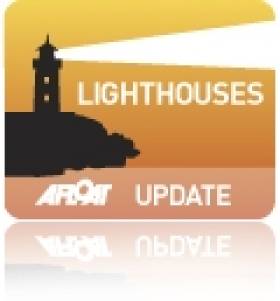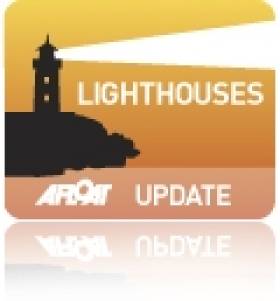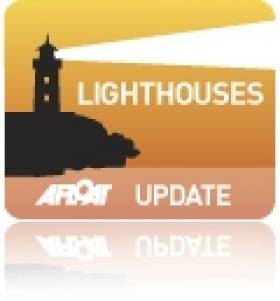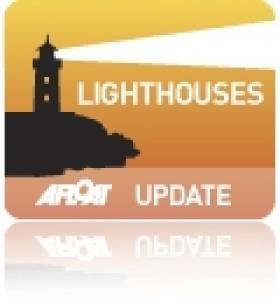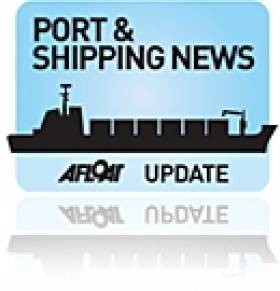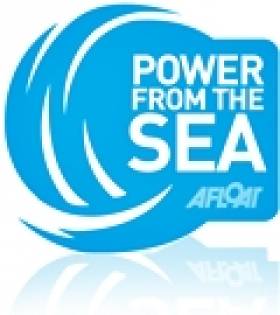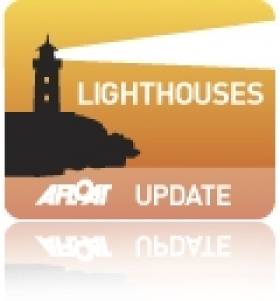Displaying items by tag: Irish Lights
#UKMetOfficeBuoy – The Commissioners of Irish Lights tender ILV Granuaile (2000/2,625grt) successfully deployed a KI buoy recently for the UK's Met Office.
The positioning of the deep-water mooring buoy took place some 250 miles west of the French port of Brest in Brittany.
The Romanian built / Dutch outfitted Granuaile, has previously carried out maintenance visits on the K1 buoy, this was the first time a completely new set of moorings was deployed.
The extreme length of the cable introduced new and potentially hazardous challenges to the ships personnel.
In total almost 2,500 meters of a mixture of rope and chain moorings were deployed in depths of 1,500 m.
The successful deployment of the deep-water mooring proved how versatile and innovative the Granuaile is and that of her crew when faced with tough new offshore challenges.
Lighthouse Tender Carries Out Trial Runs Since Modifications
#LighthouseTender- ILV Granuaile the aids to navigation tender is carrying out another trial run of systems at sea today in Dublin Bay and off Greystones, writes Jehan Ashmore.
As previously reported on Afloat.ie, the Commissioners of Irish Lights 79m tender had undergone work that has involved the installation of a new radar mast, calorifier units and modifications to the bridge.
Arklow Marine Services carried out the work while the vessel was berthed in the port along Sir John Rogersons Quay.
The 2,625 tonnes buoy-handling vessel is expected to return to her homeport of Dun Laoghaire Harbour tonight.
Fancy a Break in a Lighthouse?
#Lighthouses – Ever fancied a break staying in a lighthouse, away in some remote stretch of coastline, then look no further.
The Irish Landmark Trust, have five such lighthouse properties dotted around the coast in which the public can rent on self-catering basis.
Get to experience breath-taking views and stunning backdrops from these beautifully restored lighthouses. To view further details of each lighthouse and how to make a booking, click the links below.
Blackhead Lighthouse, Whitehead in Co. Antrim Lightkeepers House One AND Lightkeepers House Two
Galley Head Lighthouse, Clonakilty, Co Cork Lightkeepers House One AND Lightkeepers House Two
Loop Head Lighthouse, Kilbaha, Co. Clare
Wicklow Lighthouse, Dunbar Head, Co. Wicklow
For information about the role of the Irish Landmark Trust, whose remit is to save interesting and unusual 'landmark' properties throughout the island of Ireland, and to re-use them, once restored, as good quality self-catering holiday accommodation visit: http://www.irishlandmark.com/about/about-us.aspx
Lecture: Lighthouse Memories of “Round Ireland Lighthouse Tour”
#LighthouseLecture- An illustrated lecture: 'Round Ireland Lighthouses Tour' by John Donnelly and Brian Maguire will be held next Wednesday (16th Jan.) at Poolbeg Yacht & Boat Club, Ringsend, in the heart of Dublin Port.
Donnelly and Maguire worked as Engineers for the Commissioners of Irish Lights (CIL). Between them they have seventy year's experience covering the period when the lighthouses were manned and their subsequent automation.
Their presentation will feature the history of the various lighthouses along with numerous photographs and personal anecdotal memories.
The lecture starting at 20.00hrs is part of Public Les Glenans Irish Winter Lecture Series and an entry fee of €5 will be in aid of the RNLI.
Ports & Shipping Review: Manx Route Opens, Toxic Cargo-ship Leak, Replenishment at Sea, Cruise Callers, Ferry Festive Boost, Arklow Newbuild and much more
#PORTS & SHIPPING REVIEW - Over the last fortnight Jehan Ashmore has reported from the shipping scene where the Manx-UK winter operated Douglas-Liverpool (Birkenhead) route resumed service.
The port of Warrenpoint on Carlingford Lough was where 18 people suffered injuries arising from a toxic gas leak onboard Arklow Meadow, a dry-cargsship which had arrived with a cargo of grain.
For the sixth year in succession the Irish Travel Trade News Travel Awards voted Irish Ferries as Best Ferry Operator of the Year 2012.
A new book New Life for churches in Ireland, has been published and in which features the former Mariners' Church of Ireland, Dun Laoghaire, now home of the National Maritime Museum of Ireland.
Coliemore Harbour on Dalkey Sound (the medieval port for Dublin) is to undergo a survey to access structural damage on behalf of Dun Laoghaire-Rathdown County Council.
The Naval Service was kept busy within the first fortnight of this month with the detention of two foreign registered vessels for alleged breaches of fishing regulations off Castletownbere.
In a first for the Commissioners of Irish Lights and the Naval Service, a joint replenishment at sea (RAS) exercise took place involving the ILV Granuaile and coastal patrol vessel CPV L.É.Ciara (P42).
Killybegs based Sinbad Marine Services have put on sale the SMS Coastal Cat, a 12m survey workboat built locally at the Mooney Boats yard.
In 2013, ten cruise calls are scheduled to visit Dun Laoghaire, bringing around 10,000 visitors and where the 148,528 tonnes giant liner Queen Mary 2 is to make an anchorage call in mid-May.
Dutch owned heavy-lift specialist Abis Shipping are seeking professionals and trainees to work for the expanding company which this month is due delivery of newbuild Abis Dublin.
In an unprecedented move Irish Ferries are to add a third vessel between Dublin-Holyhead during Christmas and New Year periods while Stena Line are to bring back HSS fast-craft operations between Dun Laoghaire-Holyhead.
In what will be a third order for a wind-farm support vessel from Gardline UK has gone to Arklow Marine Services, the 19m newbuild is to be completed in July 2013.
Ports & Shipping Review: Cruising to the Sun, WWI Warship’s Tourist Role, Stena’s 50th Year, Cargoship Record, Dock Survey of Lighthouse tender and more…
#PORTS & SHIPPING REVIEW - Over the last fortnight Jehan Ashmore has reported from the shipping scene where Irish passengers left wintery conditions by embarking on a cruise directly from Dublin Port which was bound for sunnier climes in Iberia and the Atlantic isles.
A multi-cat workboat, Island Kestral was acquired by Wicklow based Island Shipping, the vessel will be chartered to offshore projects including the renewables industry sector.
Following the fate of the WW1 Battle of Jutland cruiser HMS Caroline, which is to remain in Belfast, the 98-year vessel is to be made into a tourist visitor attraction, likewise of London's HMS Belfast, another veteran but from WW2.
Those considering a career at sea, should take note that the National Maritime College of Ireland (NMCI) is to host a 'Open' Day next Tuesday (23 October) at the campus based in Ringaskiddy.
What's in a name...Stena Line, a household name, but did you realise that the Swedish owned ferry giant derives its name from founder Sten A. Ollsen, and this year celebrates its 50th anniversary. How did the company become to where it is today, operating 19 routes which includes Dun Laoghaire-Holyhead, served by the HSS Stena Explorer, which is to return to the route for 12 days during the festive and new year periods.
While Irish Sea rivals, Irish Ferries is to add a third ferry on to the Dublin Port-Holyhead route also to cover for the festive and new year sailings. The unprecedented transfer of the Isle of Inishmore will join the route's existing tonnage, Ulysses and fast-ferry Jonathan Swift, to provide additional capacity during the busy season.
Those with a strong interest in liners, should head for the London Ship Show next Saturday (27 October). Among the exhibitors are maritime booksellers, artists, model-makers, traders in memorabilia and ephemera postcards. There will be talks about P&O Cruises 175th anniversary 'Grand Event' in the Solent which featured the Arcadia that sailed to Dublin.
A major international conference on Ocean Energy was held in Dublin's Convention Centre and facing opposite the venue, a scientific weather buoy was positioned on the Liffey.
Passengers travelling on ferry routes will be able to have the same travel rights given to those flying or taking the train, when the National Roads Authority is to implement on 18 December.
A record breaking single cargo shipment of 56,000 tonnes of coal, was set in Belfast Harbour, when the bulk-carrier Ocean Breeze docked in the port having sailed from Virginia in the U.S.
Irish Rail which operates Rosslare Europort is to undergo a strategic review, which is predominantly served by the ferry sector, could be transferred to potentially different ownership.
Today the tallship Tenacious is having an 'Open' Day, where the public can board the 65m barque berthed at Sir John Rogersons Quay in Dublins Docklands between 10.00am-12.30pm and 2-4pm.
The hard-working lighthouse tender ILV Granuaile is undergoing a docking survey in Cork Dockyard. The vessel was built in Galati on the River Danube, Romania for the Commissioners of Irish Lights whose headquarters are in Dun Laoghaire, which is the vessel's homeport.
Buoy Takes Front Seat Row at Ocean Energy Conference
#OCEAN ENERGY – As previously reported the fourth International Conference on Ocean Energy (ICOE) which concludes tomorrow at the Convention Centre Dublin, is where an Irish Lights buoy has been deployed facing the venue's prime river frontage, writes Jehan Ashmore.
After previous ICOE conferences held in Brest and Bilbao, Sustainable Energy Authority of Ireland (SEAI) and partners European Ocean Energy Association's (EU-OEA) have brought the internationally important conference to the Irish capital. A notable feature to mark the three-day conference is the buoy, which is a Type 2 Port Laternal Marker, only one of two such buoys within the inventory of the Commissioners of Irish Lights.
It is fitted with a variety of meteorological and oceanographic sensors which will be tweeting data automatically via the automatic identification system (AIS), giving a unique insight into weather conditions outside the convention centre.
Open House Dublin takes to the Water
#OPEN HOUSE – Starting today is Open House Dublin weekend (5-7 October), which is an exploration of the vitality of Dublin through its architecture for people and to experience free of charge. A host of buildings otherwise normally closed to the general public are available to visit including maritime related tours.
An architectural tour of Dublin's Docklands quarter on board a Liffey sightseeing boat is to be presented by Minister for Education Ruairi Quinn T.D. Also taking transport while on a tour of buildings along Dun Laoghaire will be a yacht excursion along the south Dublin Bay coastline.
The Commissioners of Irish Lights, whose striking landmark headquarters in Dun Laoghaire Harbour, will be open to public tours. Further along the waterfront, close to the harbour's East Pier, is the National Maritime Museum of Ireland (NMMI) which is also to welcome visitors noting the opening hours on Sunday are between 11am to 5pm.
Please note that availability to these events which represent a handful in an extensive programme are subject to various viewing arrangements, as some had to be pre-booked, while others are based on a first-come first-served basis. For further details consult www.openhousedublin.com
Another Lightship Extinguished into History
#LIGHTSHIPS – As each day passes, quite literally chunks of Irish maritime heritage are been rapidly consigned to history, as work on scrapping the former lightship ALF Skua takes place on the North Quay in Arklow, writes Jehan Ashmore.
As the vessel lies forlornly alongside her River Avoca berth, a blowtorch cuts away in earnest at the steelwork. In tandem a crane-grabber lifts large sections of the red painted ship and loaded into an awaiting quayside truck.
What remains as of this week is only the hull, as the bridge, deckhouse structure and lantern have gone, having said that the latter structure was removed years ago.
When the lightship was towed into the port, several elected members of Arklow Town Council, with a seafaring back-round prevailed in the public body to acquire the lantern. The structure however still remains yet to be located to an appropriate site, as according to the council they have no definite plans for the lantern, though it is envisaged that it would be at least placed in a municipal location.
For decades the lightship served several stations off the Irish coastline, having been completed in 1960 by Philip & Sons of Dartmouth for the Commissioners of Irish Lights (CIL). Constructed of steel, the 134 foot lightship, cost £124,128 when launched in the Devon shipyard, though her crew were replaced when converted to an automatic light float (ALF) in 1981/82.
The vessel's designation as an ALF lasted for more than two decades until Irish Lights sold the lightship to Arklow Shipping Ltd in 2005, however she has since changed hands while moored in the Co. Wicklow port.
Nearby to where the Skua is berthed, a lantern belonging to an older lightship fleetmate, the Albratross (built 1925), was kept to form a distinctive landmark at the entrance to Arklow Marina.
With the diminishing Skua, it is believed that only two such ships survive on this island. The ALF Kittiwake (built 1959) as previously reported on Afloat.ie is in Dublin Port, however she shifted berths several months from her prominent position opposite the 02 Theatre to the jetty within Alexandra Basin, which is hidden away from general view in the working port.
The other lightship the Petrel, was built by Dublin Dockyard between 1913-15. She remains as a floating clubhouse for the Down Cruising Club in Strangford Lough, having been towed to the lough by the lighthouse tender ILV Isolda during the late 1960's.
As for the last lightship to serve, the honour was left to the ALF Gannet. She was stationed at South Rock, off Co. Down until her decommissioning in 2009 when Irish Lights replaced the lightship with a new 'Superbuoy'.
Former Irish Lights Headquarters for Sale
#PROPERTY HQ– The Irish Times reports that the Dublin based former headquarters of the Commissioners for Irish Lights are to be offered for sale at €2.85 million on the instructions of Nama – a 89 per cent per cent drop on the €26 million paid for the block in 2006 by Pembroke Partnership.
Wesley Rothwell of CBRE says the building, (located on 16-19 Pembroke Street in Dublin 2), has not been occupied since it was sold, is now in need of extensive refurbishment.
The property became redundant when the Commissioners relocated in 2008 to a brand new custom-built HQ on the waterfront within Dun Laoghaire Harbour. As previously reported on Afloat.ie, the distinctive landmark building is to be open to the public next Sunday as part of the Open House Dublin Weekend.


























